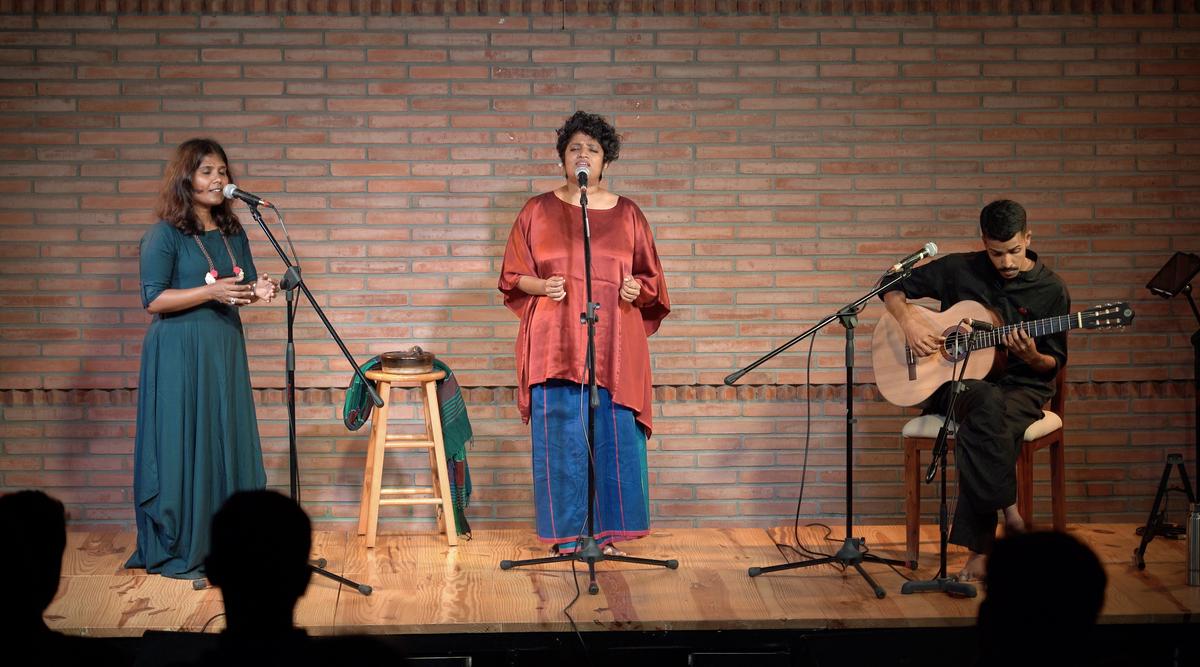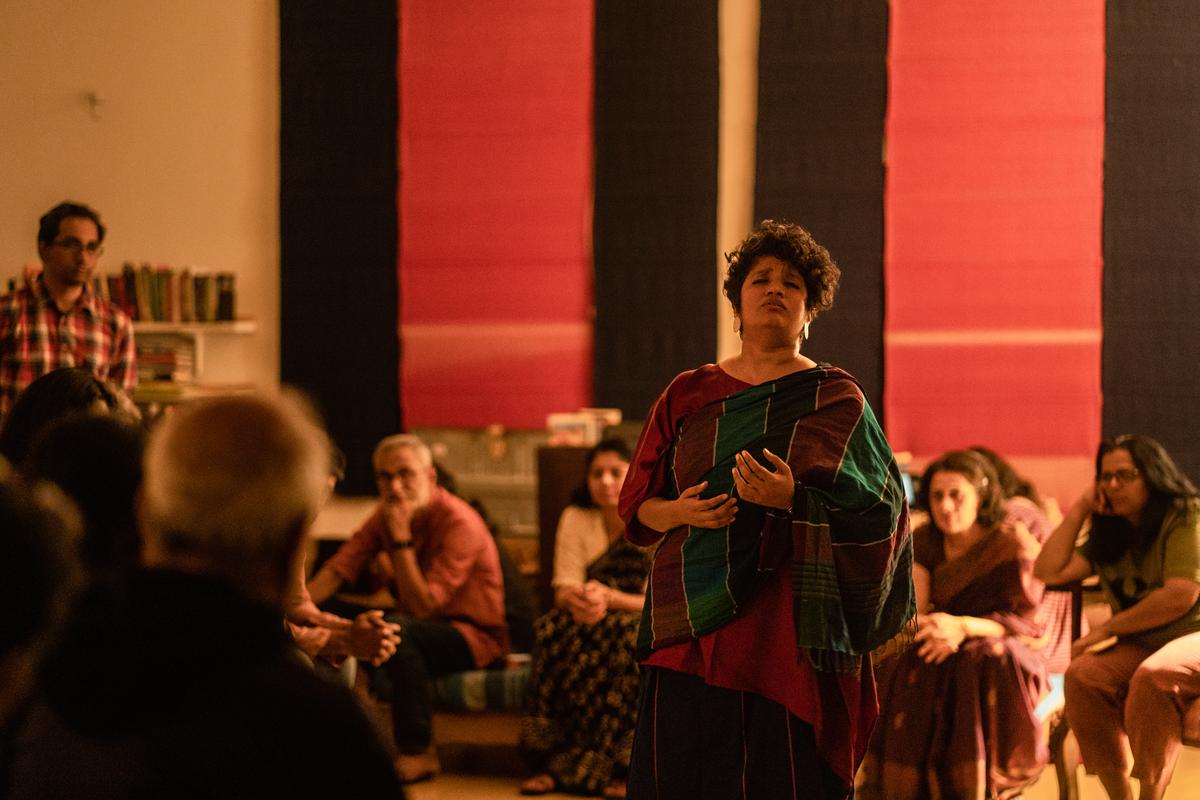Bindhumalini at the ‘Many Moons’ show
| Photo Credit: Sumukh Bharadwaj
‘Many Moons’ by Bindhumalini inhabited the liminal spaces between sound and music, cognitive understanding and intuitive knowing. The layered musical experience offered at Courtyard Koota, Bengaluru, during their sixth anniversary celebrations, invited audiences to travel softly through shape-shifting soundscapes, revisiting assumptions about what makes music. Beginning with a meditative immersion into a sound sculpture or musical installation, the programme led the audience towards a new space of listening to and thinking about music in its second part, which was somewhat like a concert but not quite.
Moving from silence, sounds and musical question marks to lyric-free melodies, tune tributes and formal compositions, ‘Many Moons’ treated audiences to a heart to heart between disparate entities in music making, without a trace of dissonance. Does sound have to be arranged for music to emerge? How does the heart instinctively hear oneness in harmony that actually has notes from different registers as its building blocks? These were just some of the questions that came up.
The first few offerings of the concert were happily unrestricted by words and carried their foundations in ancient knowledge structures ever so lightly. The singers Bindhumalini and Gurupriya Atreya effectively employed body rhythms and humming, serving up music with generous helpings of ta-ra-ra-ras and la-la-la-las to the vibrant strumming (sometimes singing, sometimes sound-making) by classical guitarist Abhaydev Praful. The composition ‘My sweet golden moon’ paid tribute to Illayaraaja’s ‘Yen iniya ponn nilave’ while baring the intimate connection between music and memories. ‘Rain and smoke’ was energetic and continued in the style of swara-strings. ‘Auto-tune,’ it turned out, was so titled because it was created in an auto — not because it was a lofty contemplation on the relationship between music and spontaneity.

Bindhumalini, Gurupriya Atreya and Abhaydev Praful
| Photo Credit:
Sumukh Bharadwaj
These pieces defied classification though they resonated with multiple musical genres including jazz, classical music and film music. They displayed the scope of the human voice to be a musical instrument, possibly even an extension of the human mind when it is not feeling stuck in its cerebral duties. The music was playful, often dismissing language and opening avenues for the audience to make its own meaning of melody, rhythm and the dots that may or may not join them.
The next few pieces echoed familiarity — one a song of lament, another a lullaby, and the third — a timeless classical composition, all set to the Carnatic raga Bhairavi. While the first two were presented in snatches, the magnificent ‘Kamakshi’ was presented as the grand finale, in all fullness. This piece came as a complete surprise, even stoking resistance in my mind, attuned by then to the explorative approach of the concert. Yet, how long can the heart or head hold out against Bhairavi and such a rich ode to the divine feminine as is ‘Kamakshi’? Also, by the end, the concert held out its promise of leaving loose ends untied, which felt just right.
Bindhumalini marvels at the “magic, hiding in plain sight,” while speaking of an “underlying unity of notes” in what is called Natabhairavi in Carnatic music, Asavari in Hindustani music and the Natural Minor scale in Western music. Having stumbled on a host of cross-cultural approaches to this scale during research for another musical composition, she delved further into Natabhairavi’s offshoots and worldwide avatars to make ‘Many Moons’. She wished for the processes behind the show to be seen, for the output to be “a warm welcome into a shared experience” than a “display” of the raga’s range and manifestations.
This was the intent behind sharing with the audience — playlists from the research phase and voice recordings from other musicians on their relationship with the scale, both of which played outside the venue, before and after the show. The audience was also invited to soak in “the study material” that got created and then became the musical installation, a crucial part of the programme. She credits team Courtyard Koota led by Natasha Iype (architect and artistic curator of the space) with enabling such open-ended, experimental work; with showering “mad trust” alongside other team members like Priyanka Chandrasekar, Divya Sarangan, Sridhar Varadarajan and others who worked on production, research, editing, sound and other aspects of the show.

‘Many Moons’ was an immersive experience
| Photo Credit:
Sumukh Bharadwaj
Bindhumalini carries many accolades earned at the national and international level with much lightness, makes music for films, sometimes works as an actor in the theatre and engages deeply with multiple musical genres through performance, composition and research. She’s constantly collaborating with musicians and artistes from diverse backgrounds because, she says, it opens a “common space of shared creativity” that is greater than the individual artistes and their talents.
She shares a story from her school life while speaking about the title of the show. She and her friend had gleefully gotten away to the terrace to view the moon. They both didn’t have their glasses (that they needed) but saw what they saw in the moon — each her own way, even describing it with much delight to the other. Though there was a single moon in the sky, they feasted together on many moons. This is the essence she sought to bring into ‘Many Moons’, says Bindhumalini.